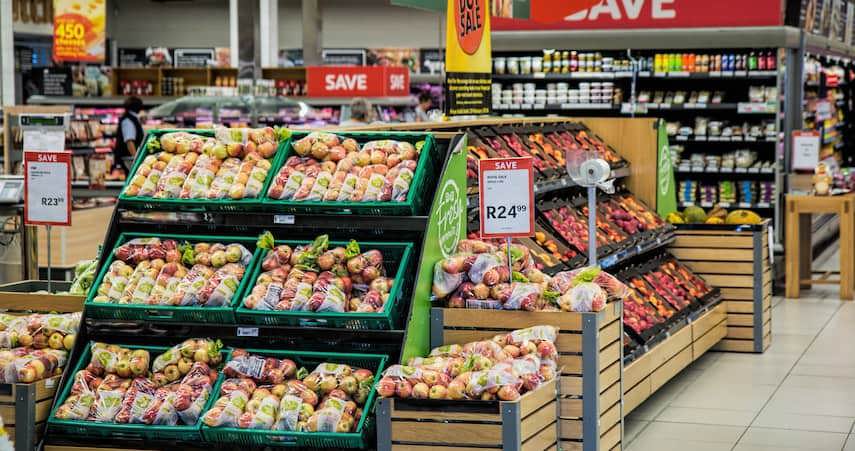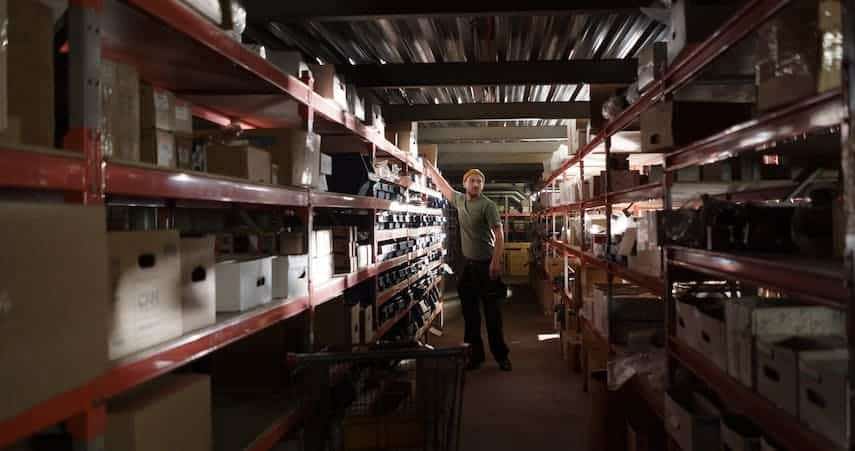
An endless aisle strategy can help you overcome the challenges of limited storage and locked-up cash flow. For retailers, this useful tactic offers many competitive advantages and tempting benefits.
But how does it work? What are the strategies, what are the risks? Keep reading to find out.
What is the endless aisle?
The endless aisle is a sales system in which retailers can provide their in-store customers with the chance to order products that are currently out of stock or not normally sold instore. Endless aisle products can then be shipped directly to the customer or picked up instore at a later date.
For independent retailers, an endless aisle inventory strategy can help boost your ability to compete with large retail chains and ecommerce stores. Endless aisles enable you to offer a larger range of products and potentially drive more customers to your store.
 An endless aisle strategy can be a powerful tool for small businesses to compete with their larger competitors.
An endless aisle strategy can be a powerful tool for small businesses to compete with their larger competitors.
4 profitable endless aisle strategies
Endless aisle strategies add virtual stock to your product range – not physically present, but still available for your customers to purchase in-store. Customers can shop from your shelves or choose from your virtual collection.
These endless aisle strategies can help to ensure customers will leave your store having made a purchase.
1. Kiosks
In-store kiosks are touch screen displays often used as part of a business’s endless aisle strategy. This provides consumers with an interactive online shopping experience to enhance the client experience and maintain customers.
An endless aisle kiosk enables shoppers to:
- Access an unlimited range and assortment of items
- Browse and shop the store’s entire catalogue
- Get out-of-stock products shipped directly to their homes
- Combine the brick-and-mortar retail experience with the convenience of online shopping
Kiosks can also help you to improve sales by capturing those customers who may have otherwise gone to a competitor. They’re well-suited to businesses with a range of bulky inventory, such as furniture, white goods, and sporting equipment.
Retail chains can also use endless aisle kiosks to reduce overheads.
2. Showrooming
Showrooming is when consumers examine merchandise instore then purchase it online, usually at a lower price.
Showrooming as an endless aisle tactic allows customers to browse products in-store and then scan a QR code to complete their purchase online.
Visiting a physical store allows customers to touch, test and try out products before making a purchase decision. When your customer scans the QR code next to an item, they’re directed to your landing page where they can have a more immersive shopping experience. Customers can then view product information, demonstration videos, discounts, and complementary products.
QR codes in your showroom or advertisements give you the opportunity to expand your product range beyond the physical limitations of your store. This allows smaller retailers to overcome the challenges of limited space and limited resources.
3. Dropshipping
Dropshipping is regularly used in ecommerce to reduce the costs associated with holding stock.
A dropshipping business lists an item online that they do not hold in stock. When a customer places an online order, the seller purchases the item from the supplier, who subsequently ships the product directly to the customer.
As the retailer or ecommerce seller, you never take physical ownership of the goods, only purchasing a product when you’ve already sold it. With dropshipping you are still the seller on record. This means you maintain control of the retail price, promotions, and customer service.
The main benefit of dropshipping is that it helps you to mitigate inventory risk.
You can reduce the amount of inventory you hold, freeing up capital and optimising cash flow. Dropshipping also helps improve profitability by reducing warehouse and storage space.
 Dropshipping is a popular and cost-efficient endless aisle strategy that requires no storage space or on-hand inventory.
Dropshipping is a popular and cost-efficient endless aisle strategy that requires no storage space or on-hand inventory.
4. Hybrid dropshipping
Hybrid dropshipping is an endless aisle method that enables retailers and distributors to sell products from their own on-hand inventory as well as place orders directly with the supplier.
This approach enables you to source the best prices, have inventory in stock, and fill your catalogue with a greater volume of items than you’re capable of storing inside your facilities.
Implementing standard or hybrid dropshipping to manage online sales is great for cash flow: you’re not holding large volumes and varieties of inventory stock.
However, it’s important to have a degree of visibility into your suppliers’ inventory levels to know that your customers orders can still be fulfilled.
The most effective way to do this is by utilising online inventory management software like Unleashed that offers ‘data feed’ capability. Cloud-based inventory software automatically updates product information and inventory quantities from various storage locations, including your suppliers’ warehouse.
How does the endless aisle help with retail inventory?
Endless aisles give customers easy access to digital shopping. Transactions can be completed simply and quickly via mobile smartphone apps. But they’re not just for the customers’ benefit.
Let’s look at some of the core inventory management benefits of an endless aisle strategy.
Increase sales and profits
Endless aisles allow you to provide a wider range of products than what you can stock in your physical store. This can help increase sales because your customers have greater options and are more likely to find what they’re looking for.
Endless aisles also help foster opportunities for you to cross-sell and up-sell products.
Leverage endless aisle by maintaining product markups, regardless of location to increase your profit margins.
Better inventory control
Inventory management is a challenging part of any business.
Retailers and ecommerce stores need to effectively balance inventory to ensure they can satisfy consumer demand while minimising the risks of holding too much inventory stock.
An endless aisle inventory strategy provides a solution to help maintain inventory control and to reduce inventory holding costs.
Supply chain confidence
The pandemic brought with it significant challenges for supply chains globally and many have yet to fully recover. It also shone a light on problems that already existed and the challenges to the flow of raw materials that are still disrupting manufacturing.
For endless aisles to work efficiently you need to minimise supply chain risk with through supply chain mapping and transparency.
This means knowing where the manufacturing facilities of your suppliers and even their suppliers are physically located, and the parts and products that are manufactured at each location.
 Endless aisles help to mitigate supply chain risks by minimising touch points between consumer and product.
Endless aisles help to mitigate supply chain risks by minimising touch points between consumer and product.
Save the sale
With endless aisles you can circumvent customer frustration or the loss of a sale to a competitor.
Endless aisles help to save the sale by ensuring all products, in every size and colour are available and ready to purchase. Saving a sale helps you to deliver a better shopping experience to your customers and can improve in-store sales.
Omnichannel shopping carts
Omnichannel shopping carts eliminate information silos and problems between in-store and online transactions.
An omnichannel shopping experience gives your customers the chance to begin their shopping journey from anywhere. Cart transactions include products purchased in-store or online and they provide you with a single view of customers, orders, and products.
Customer satisfaction
The quality of the shopping experience is what ultimately guides consumers to be return shoppers or brand loyal. While an increasing number of consumers love to shop from the convenience of home, many still enjoy an instore experience.
Endless aisles appeal to the contemporary demand for multichannel shopping experiences. They reduce the risk of losing a customer due to frustrating in-store stockouts.
Endless aisles also improve your customers’ experience and satisfaction levels because you can provide a more personal interaction and insight on the benefits of your products.
Fewer returns
A mismatch in expectations is what frequently drives shoppers to return an online purchase.
Endless aisles can significantly reduce the likelihood of a return because shoppers get to touch and try products before they purchase them. Combining the physical store experience with endless aisle tactics often provides the best customer experience, and the lowest number of returns.
Challenges and risks of the endless aisle
Although endless aisles offer many benefits to retailers, there are still some potential risks and challenges.
Let’s explore a few of the most common ones.
1. Stock visibility
Inventory levels fluctuate across your instore and online sales channels. Without updated real-time visibility of your inventory, you can’t offer your customers different options, and failure to deliver could mean you risk losing them to a competitor.
Inventory management technology that integrates with other software systems will ensure you have real-time stock visibility of your products and where they are located.
2. Staff training
Once you’ve optimised your inventory you need to empower your employees.
Your staff need to understand assisted sales. This is critically important considering a PWC report that determined 59% of all consumers feel companies have lost touch with the human element of customer experience.
Staff must also have easy access to inventory levels including from a cashier’s point-of-sale screen, or a sales rep’s order management system.
By ensuring your team have the appropriate access to inventory stock and locations they can communicate this to customers. Inventory that is not in stock can then be shipped from another location direct to the customer or for pick up instore.
 A major benefit of endless aisle strategies is the ability to make sales irrespective of stock-on-hand levels and lead time.
A major benefit of endless aisle strategies is the ability to make sales irrespective of stock-on-hand levels and lead time.
3. Dealing with suppliers
Working with and managing the order processes with your dropship suppliers is also a major challenge of endless aisles.
It’s imperative you have a three-way match process in place to mitigate the risk of paying inaccurate or fraudulent invoices. Three-way match comprises the seller’s invoice for the order, the retailers purchase order, and the retailers receiving report.
This helps to ensure that vendors are invoiced correctly for products ordered at the price expected, and you can track that the items were actually shipped to your customer.
4. Customer communications
Communicating with your customer when you haven’t got physical possession of a product can also be tough.
When placing an order instore, via a kiosk, or using a QR code your customers aren’t leaving with their purchase in-hand. They’re trusting that you will deliver the items as promised. If shipping status notifications are coming from the supplier, it can be difficult to track and communicate this information to your customer.
You need to have the right retail software to keep the customer informed on the status of their order, the moment the products are shipped and when they can expect to receive their goods.
5. Zombie SKUs
Zombie SKUs are by-products of endless aisle strategies that cause a glut of millions of inventory SKUs online.
When advertising search engine algorithms test all your products they will find and focus on the ones with the best price and theoretically the best chance to sell. Zombie products result when your other products receive minimal attention, have zero engagement, generate little revenue, cost time and resources to maintain.
Zombie products can negatively impact your website speed, user experience, and can escalate cart abandonment rates. An automated system to improve the rotation of your product feed while helping to reduce the risk of zombie SKUs.
